-
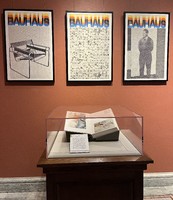
-
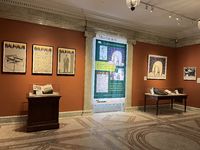
-
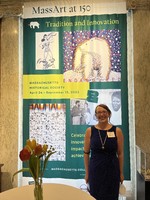
-
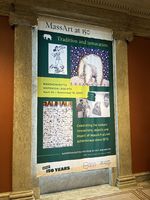
-
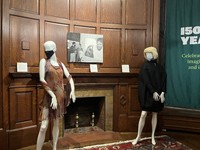
-
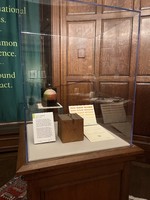
-
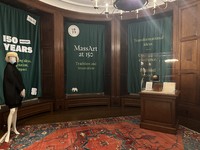
-
The Studio for Interrelated Media (SIM) was founded in 1969 by MassArt
faculty member Harris Barron, class of 1954 (Ceramic Design), who
taught from 1963 until his retirement in 1988. Influenced by the rise
of performance art in the 1960’s, SIM was one of the first-of-its-kind
interdisciplinary, idea-focused, and non-media specific programs.
SIM students explore their ideas through light, sound, digital media,
and performance with a focus on experimentation, collaboration, and
civic engagement. This makes much of the artwork produced meant to
be experienced in the moment and ephemeral.
The precursor to SIM at MCA was ZONE (1968-1972), a visual theater
troupe founded by Barron, his wife Ros, and their former studio assistant,
Allen Finneran. In 1972, MassArt created the Media and Performing Arts
Department and Harris served as its first chair. With the creation of the
department came the opportunity for students to major in SIM and the
program entered its first stage of real growth.
-
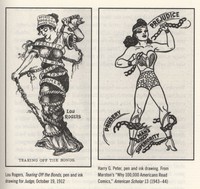
Annie “Lou” Rogers earned her certificate in Elementary Drawing and
Design in 1900 from Massachusetts Normal Art School. She began
her career submitting work as “Lou Rogers” to get around the barrier
of sexism at the time. She became a successful cartoonist, with work
featured in publications such as Judge magazine, New York Call, Woman’s
Journal, and Birth Control Review. Throughout her life, Rogers was clear
in her support of “radical” activism efforts, such as feminism, socialism,
and women’s suffrage, with the latter being the most notable topic in
her published cartoon work. While working as a staff artist at Judge,
Rogers met illustrator H. G. Peter. Her feminist-slanting work inspired
Peter to develop what would become the Wonder Woman cartoon, and it
is because of Rogers’ focus on depicting women freeing themselves from
existing social bondage of the time that Wonder Woman emerged as a
feminist icon.
-

Albert Munsell, class of 1881, earned his certifications at the Massachusetts
Normal Art School (MNAS). They were in Elementary Drawing; Form, Color,
and Industrial Design; the Constructive Arts; and Sculpture and Design
in the Round-Modeling and Casting. He was a painter, longtime faculty
member of MNAS, author, and innovator. His inventions included an artist’s
easel, photometer, Munsell crayons, and the Color-Sphere and mount.
Munsell developed this 3-dimensional model for organizing and describing
color. Because he developed it on the basis of perception, not physics or
chemistry, Munsell’s Color System became arguably the most effective
system for organizing color ever invented. His work would influence the
“Color Standard for Frozen French Fried Potatoes” in 1966, to ensure
optimal enjoyment by customers. That is just one example. Users of his
Color System have included NASA, the U.S. Bureau of Standards, Microsoft,
Apple, Hershey, Coors Brewery, Toro, and the government of Japan, to
name only a few.
-

Jim Warner, class of 1984 (Industrial Design), helped design packaging for some of the world’s most recognizable brands, including the Lay’s Stax potato chip container and Pepsi products, such as the Aquafina water bottle. Other recognizable packages he helped design are Doritos, Fritos, Coffee-Mate, Glad-Ware, a Crest Complete Toothbrush, a Thermos insulated mug for Target, Nestle Coffee-Mate and Hellmann’s Mayonnaise.
Warner holds over 130 patents, and he has increasingly focused on
eco-friendly design. Between 2011 and 2022, he developed and patented
Paper Bottle 360, a sustainable packaging solution. He has earned
numerous global innovation and environmental awards.
-
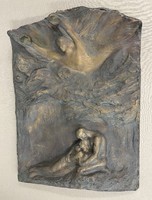
Bashka “Bessie” Paeff, class of 1911, was a sculptor whose work included
realistic animal sculptures, portraits, and war memorials. She was
nicknamed the “Subway Sculptor” for her work in the Park Street MBTA
Station. At 22, Paeff won a commission from the state of Maine to create
a World War I memorial. Her design, “Sacrifices of War,” is a large relief
sculpture depicting a mother protecting her child from the ravages of war.
Newly-elected Maine Governor Ralph Owen Brewster was apprehensive
about the feminist, pacifist message, and tried to derail the effort in
favor of another of her works, “Glories of Peace” (seen here). She
prevailed with the help of the previous governor, and “Sacrifices of War”
was dedicated in 1926. Some of Paeff’s notable works located in Boston
include “Boy with a Bird” in Boston Public Garden and a bronze relief of
Dr. Martin Luther King, Jr. at Boston University.
-
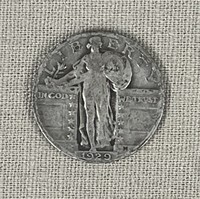
Herman MacNeil, class of 1886, designed the Standing Liberty Quarter,
which circulated between 1916 and 1930. His original design showing
a bare-breasted Liberty offended the sensibilities of some, and U.S.
Treasury officials asked him to redesign the coin, this time with Liberty
modestly attired.
-
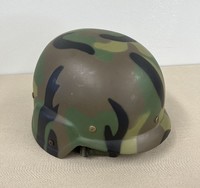
Albert Petitto, class of 1944 (Art Education), was a sculptor. In 1975, he
worked with the United States Army Laboratories in Natick, MA to design
the Army’s first new helmet since World War II. Previous helmets proved
too heavy and hot to wear, prompting soldiers to remove them while in
dangerous war zones. Petitto created the lighter, better-fitting Kevlar
helmet that Army soldiers wore from the mid-1980s to the mid-2000s.
-

Pamela Parisi, class of 1967 (Graphic Design) found success as Director
of Global Design at Gillette Procter & Gamble. During her 30 years at the
company, she oversaw the product packaging development of the Gillette
Mach 3 and Venus Razors in the 2010s, among many other products.
Following her retirement from Gillette, Parisi served on MassArt’s Board
of Trustees from 2012 to 2022.
-
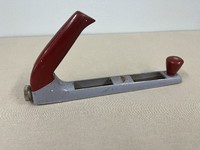
L. Garth Huxtable, class of 1933 (General Design) was born in Nova Scotia
and raised in Fitchburg, MA. He designed hundreds of products for major
companies, but his most enduring impact was on the shape of American
hand and power tools designed for Millers Falls Tools in Montague,
Massachusetts. These designs include this Miller Falls Model C 3/8
electric drill and the Plane-R-File from the 1950s, both of which earned
international acclaim, winning silver medals at the Triennale di Milano
in 1954 and 1957, respectively. His work was known to be simple and
direct, with form, function, and construction equally important to his
designs. This no-frills take on design also appeared in his work with
cookware and tableware.
-

-
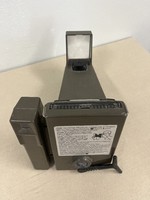
William (Bill) Hannon, class of 1956 (Advertising and Product Design),
returned to MassArt to serve as a faculty member in Industrial and
Graphic Design in 1976. He also served as Chair of the Environmental
Design Department and Vice President of External Affairs for the
college. While at MassArt, Bill founded the Design Management
Institute (DMI) in 1975, a global non-profit dedicated to connecting,
promoting and elevating the role of design in business, culture and
society. Hannon had an illustrious career as an industrial designer
working on medical equipment, logos, corporate identities and, most
famously, the Polaroid Big Shot Camera in 1971. This popular camera
was used by iconic visual artist Andy Warhol, who appreciated its ability
to instantly capture the close-up images that the artist used to make
his famous silkscreen portraits.
















